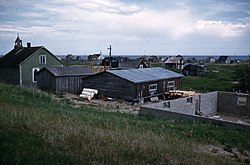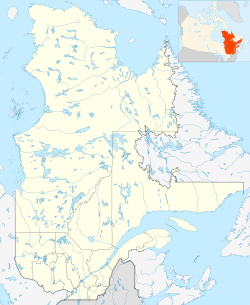Moisie (Quebec French pronunciation: [mwazi]) is a district (secteur) of the city of Sept-Îles, Quebec, Canada.[2]
Moisie | |
|---|---|
District and former city | |
 | |
| Coordinates: 50°11′29″N 66°5′40″W / 50.19139°N 66.09444°W | |
| Country | Canada |
| Province | Quebec |
| Region | Côte-Nord |
| RCM | Sept-Rivières |
| Municipality | Sept-Îles |
| Municipality | January 1, 1955 |
| City | October 29, 1983 |
| Amalgamated | February 12, 2003 |
| Area | |
| • Land | 1,396.99 km2 (539.38 sq mi) |
| Population (2001)[1] | |
• Total | 930 |
| • Density | 0.7/km2 (2/sq mi) |
| Time zone | UTC-5 (EST) |
| Postal code | G0G 2B0 |
| Area code(s) | 418, 581, and 367 |
| Geographical code | 24 97005 |
Prior to February 12, 2003, Moisie was an independent city; on that date, it and the Municipality of Gallix were merged into Sept-Îles.
History
editOriginally Moisie was a small fisherman village located at the mouth of the Moisie River. Its name, taken from this river, has been in use since the 17th century and its meaning and origin are unknown.[3] The village, which was at sea level, was relocated in 1967 after several storm surge floods.
Molson Inc. established a smelter on the other bank of the river in the late 19th century. The company was plowing through three feet of pure iron black sand lying on the beaches as raw material for the forge. Prospectors later explored the region upstream of the river which led to the discovery of large iron ore deposits around Labrador City and Schefferville.
Between 1933 and 1949, the Hudson's Bay Company had a post at Moisie, operating as an outpost of Sept Iles.[4]
On January 1, 1955, the Municipality of Moisie was created out of territory ceded by the Township of Letellier.[5]
The community became home to RCAF Station Moisie in the late 1950s, when the Royal Canadian Air Force established a Pinetree Line early warning radar station nearby. The facility was later renamed CFS Moisie and closed by the early 1990s after defence cutbacks.
On October 29, 1983, the Municipality of Moisie and the Municipality of Rivière-Pigou merged to form the City of Moisie. On February 12, 2003, the City of Moisie was amalgamated into Sept-Îles.[6]
Demographics
edit
|
| ||||||||||||||||||||||||||||||||||||
| Population counts are not adjusted for boundary changes or mergers. Source: Statistics Canada | |||||||||||||||||||||||||||||||||||||
References
edit- ^ a b "Community Highlights for Moisie, 2001 Census of Population". www12.statcan.gc.ca. Government of Canada - Statistics Canada. Retrieved 13 June 2024.
- ^ "Moisie". Geographical Names Data Base. Natural Resources Canada. Retrieved 13 June 2024.
- ^ "Banque de noms de lieux du Québec: Rivière Moisie". toponymie.gouv.qc.ca (in French). Commission de toponymie du Québec. Retrieved 13 June 2024.
- ^ "Hudson's Bay Company: Sept Iles". pam.minisisinc.com. Archives of Manitoba - Keystone Archives Descriptive Database. Retrieved 13 June 2024.
- ^ "Répertoire des entités géopolitiques: Moisie (municipalité) 1.1.1955 - 29.10.1983". www.mairesduquebec.com. Institut généalogique Drouin. Retrieved 13 June 2024.
- ^ "Répertoire des entités géopolitiques: Moisie (ville) 29.10.1983 - 12.2.2003". www.mairesduquebec.com. Institut généalogique Drouin. Retrieved 13 June 2024.
External links
editMedia related to Moisie at Wikimedia Commons
